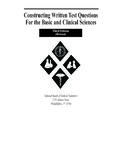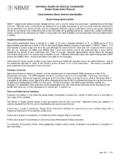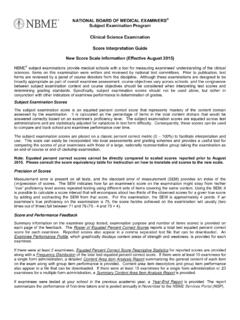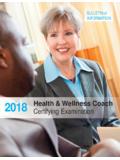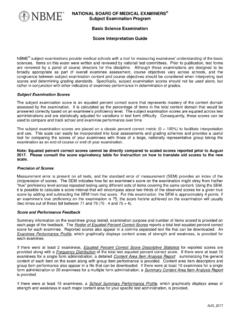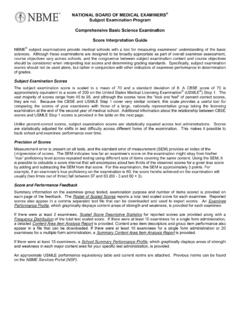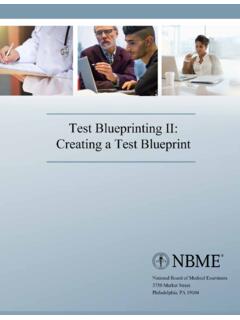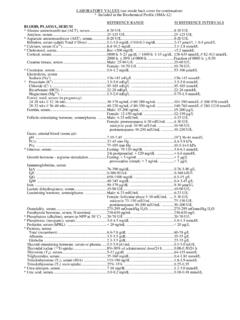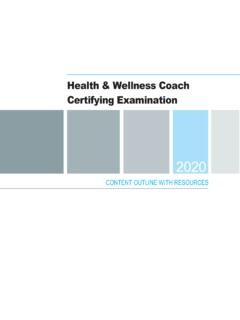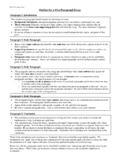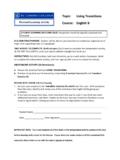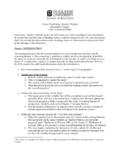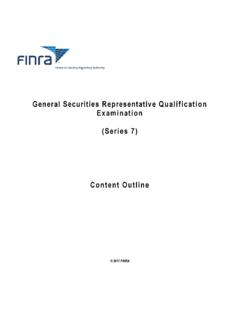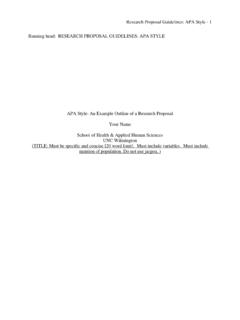Transcription of Health & Wellness Coach Certifying Examination
1 Health & Wellness Coach Certifying Examination 2018 CONTENT outline WITH RESOURCES Copyright 2017 by the National Board of Medical Examiners (NBME ) and the International Consortium for Health & Wellness Coaching (ICHWC). All rights reserved. 1 Health & Wellness Coach Certifying Examination Content outline with Resources Table of Contents How to use this Content outline with Resources .. 2 1. Coaching Structure .. Coach preparation prior to session .. 4 First session or before begin .. 5 Early (typically in the first, second or other early session) .. 6 Routine Follow-Up Sessions .. 7 Coaching Program Termination .. 8 2. Coaching Process: Coaching Relationship/Communication/Techniques .. Client-centered relationship .. 9 Trust & rapport .. 10 Active listening and presence .. 11 Client emotions and energy .. 12 Reflections .. 13 Expand the conversation .. 14 Focus and refocus the conversation.
2 15 Assist client to evaluate and integrate Health information .. 16 Goals and implementing action .. 16 Client awareness, perspective shifts and insights .. 18 Client s freedom of choice, autonomy, and intrinsic motivation .. 19 Client self-efficacy .. 20 Improve support .. 21 Client active experimentation and self-discovery .. 22 Increase positive psychological resources .. 23 3. Health & Wellness .. Health , Health promotion and disease prevention, applying a whole person perspective .. 25 Chronic Disease .. 26 Health behaviors, social and behavioral risk factors .. 30 4. Ethics/Legal .. Professional Conduct .. 36 Ethics .. 36 Legal .. 38 Copyright 2017 by the National Board of Medical Examiners (NBME ) and the International Consortium for Health & Wellness Coaching (ICHWC). All rights reserved. 2 Health & Wellness Coach Certifying Examination Content outline with Resources How to use this Content outline with Resources: The Examination covers the following categories: 1.
3 Coaching Structure 17- 23% 2. Coaching Process (Relationship/Communication/Techniques) 47- 53% 3. Health & Wellness 17- 23% 4. Ethics/Legal 7- 13% Read the Overview and specific Competencies. For most topics, you should recognize the content from your training program. Therefore, we recommend reviewing the materials from your program. Resources. If the topic sounds unfamiliar, or if it was not covered by your training program, you would like ly benefit from further study. To assist you, we suggest r esources with page numbers that correspond to specific topics. Note that many suggested resources cover the same topics. We encourage you to select those you prefer, as well as use other resources you already have. Copyright 2017 by the National Board of Medical Examiners (NBME ) and the International Consortium for Health & Wellness Coaching (ICHWC). All rights reserved.
4 3 Health & Wellness Coach Certifying Examination Content outline with Resources For your convenience, below is the list of books referenced throughout the Content outline . Note that the outline also contains web links and peer-reviewed journal articles (with free full-text links). Arloski, M. (2014). Wellness coaching for lasting lifestyle change. Duluth, MN: Whole PersonAssociates, Inc. Bark, L. (2011). The wisdom of the whole: coaching for joy, Health , and success. San Francisco,CA: Createspace. Dossey, B. M., Luck, S., & Schaub, B. G. (2015). Nurse coaching: integrative approaches forhealth and wellbeing. North Miami, FL: International Nurse Coach Association. Jordan, M. (2013). How to be a Health Coach : an integrative Wellness approach. San Rafael, CA:Global Medicine Enterprises, Inc. Kimsey-House, H., Kimsey-House, K., Sandahl, P., & Whitworth, L. (2011). Co- active coaching:changing business, transforming lives.
5 Boston, MA: Nicholas Brealey Pub. Livingstone, J. B., & Gaffney, J. (2016). Relationship power in Health care: science of behaviorchange, decision making, and clinician self-care. Boca Raton, FL: CRC Press, Taylor & FrancisGroup. Miller, W. R., & Rollnick, S. (2013). Motivational interviewing: helping people change. New York:Guilford Press. Moore, M., Jackson, E., & Tschannen-Moran, B. (2015). Coaching psychology : Wolters Kluwer. Muth, , & Green, (2014). Coaching behavior change. San Diego, CA: American Councilon Exercise. Prochaska, , & Prochaska, (2016). Changing to thrive: using the stages of change toovercome the top threats to your Health and happiness. Center City, MN: Hazelden is always looking to expand our resource list. Please let us know if there are other references you find helpful. Contact us at Copyright 2017 by the National Board of Medical Examiners (NBME ) and the International Consortium for Health & Wellness Coaching (ICHWC).
6 All rights reserved. 4 1. Coaching Coach preparation prior to session Overview Prior to a coaching session, the Coach reviews materials, eliminates distractions, and takes time to become mindful and present. The Coach s state helps the client become calm and receptive, which fosters self-awareness and self -discovery. Competencies Coach is calm, present, and emotionally available Review available client materials Logistics (meeting location, conference call arrangements, etc.) Resources Bark, L. (2011). The wisdom of the whole: coaching for joy, Health , and success. pp 287-289 (Topic ). Dossey, , Luck, S., & Schaub, (2015). Nurse coaching: integrative approaches for Health and wellbeing. pp 86-87 (Topic ). Livingstone, , Gaffney, J. (2016). Relationship power in Health care: science of behavior change, decision making, and clinician self-care.
7 Pp 64-67, 71-79, 148-150 (Topic ). Moore, M., Jackson, E., & Tschannen-Moran, B. (2015). Coaching psychology manual. pp 32-35 (Topic ); p 156 (Topic ) . Copyright 2017 by the National Board of Medical Examiners (NBME ) and the International Consortium for Health & Wellness Coaching (ICHWC). All rights reserved. 5 First session or before begin Overview The Coach s aims for the initial session, or intake session, are to describe the coaching process, review information and assessments provided by the client, and determine if the client is an appropriate candidate for coaching. The Coach clarifies roles and expectations; , the Coach will not diagnose or prescribe, nor give unsolicited advice; the client will self-determine his/her vision, goals, and action steps; and the client will be actively engaged in trying new behaviors as planned with the Coach .
8 Logistics and responsibilities (client vs. Coach ) are confirmed in a written Coaching Agreement. Competencies Set the climate/stage Establish rapport Gauge client s intentions for coaching/obtain information why coaching is sought Determine if the individual is a candidate for Health and Wellness coaching and is an appropriate candidate for you specifically Explain the coaching process Establish the Coaching Agreement Guidelines and specific parameters of the coaching relationship ( , roles, logistics, fees, scheduling, inclusion of others if appropriate, confidentiality) Client vs. Coach responsibilities, setting appropriate expectations Understand type of coaching relationship ( , short laser coaching session vs. long-term coaching relationship, telephonic, coaching apps, face-to-face, incentivized coaching) Review assessments, if any used, and other data sources Ensure appropriate time management of this and all sessions Resources Arloski, M.
9 (2014). Wellness coaching for lasting lifestyle change. pp 101-115 (Overview); pp 130-149 (Topic ). Bark, L. (2011). The wisdom of the whole: coaching for joy, Health , and success. p 283 (Topic ); pp 28-30, 33-36, 62-80 (Topics , ); pp 130-134, 327-328 (Topic ). Jordan, M. (2013). How to be a Health Coach : an integrative Wellness approach. pp 75-83 (Overview). Kimsey-House, H., Kimsey-House, K., et al. (2011). Co- active coaching: changing business, transforming lives. pp 22-27 (Overview). Moore, M., Jackson, E., & Tschannen-Moran, B. (2015). Coaching psychology manual. pp 155-167 (Overview); pp 20-22 (Topic ); pp 126-129 (Topics , ); pp 113-124 (Topic ); p 156 (Topic ). Copyright 2017 by the National Board of Medical Examiners (NBME ) and the International Consortium for Health & Wellness Coaching (ICHWC). All rights reserved. 6 Early (typically in the first, second or other early session) Overview In the initial stages of coaching, time is spent exploring the client s values, vision, purpose, and priorities.
10 The Coach refers to these in subsequent sessions to elicit motivation. During early sessions, the Coach also spends adequate time exploring the client s understanding of his/her Health and Wellness , so goals are not set prematurely. Note that when choosing a focus (Topic ), the Coach is not the expert deciding what is most appropriate; instead, the client is empowered to select an area that feels important, motivating, or timely. Competencies Have client assess current state of his/her Health and/or wellbeing Explore the client s vision of his/her optimal Health and/or wellbeing Identify gaps between current state and client s desired lifestyle/outcomes Explore client preference for priority areas of focus Establish or refine client s specific long-term goals that lead toward desired outcomes Establish or refine client s short-term SMART goals or action steps for what will be accomplished between sessions Support the client in achieving the SMART goals or action steps including back-up plans Establish client s preferences for maintaining accountability Resources Arloski, M.
